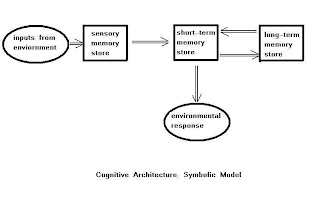Cognitive psychology perceives human mind as a biological information processing system developed by evolution, whereas computer is man-made information processor. Aaron Sloman, philosopher and researcher on artificial intelligence and cognitive science wrote in the article titled, TheArchitecture of Brain and Mind: “Biological information processing systems produced by evolution still far outstrip both our understanding and our practical achievements: there are deep gaps in our theories and in our engineering capabilities.”
Computational theory of mind and cognitive architecture
The computational theory of mind is the view that the human mind is an information processing system and that thinking is a form of computing. This view is common in modern cognitive psychology and is presumed by theorists of evolutionary psychology. The design on mind’s information processing components and systems is called cognitive architecture. According to this concept the distinction between short-term memory system and long-term memory system is architectural distinction just like the distinction between a house and a church.
Some theorists argue that mind is built from independent processing modules. Each module is specialized for a particular function such as recognizing human faces or speech. An alternative point of view is that the building blocks of the mind are flexible, general-purpose mechanisms that perform many diverse functions. Long-term memory system is one such general purpose mechanism in that it stores mental representations of both faces and speech sounds from the past to enable recognition in the present and future.
Symbolic models of mind
 |
| Symbolic model of mind |
There are two models for the architecture of mind, symbolic and connectionist. The symbolic models assume that the mind is built like a digital computer. Pioneering works on computers by von Neumann in the late 1950s provided the foundation for such models. The data in a computer are processed according the rules of a program. The symbolic models of cognitive processes assume that mental representations are symbols that are serially processed by a set of rules, just as the computers do. Herbert A Simon, father of artificial intelligence and Nobel Prize winner wrote: “ The Physical Symbol System Hypothesis states that a system will be capable of intelligent behaviour if and only if it is a physical symbol system. A physical symbol system is a system capable of inputting, outputting, storing, and modifying symbol structures, and of carrying out some of these actions in response to the symbols themselves.” (Page 3 Invariants of Human Behaviour) This class of architecture posits a centralized control system over the information process of the mind. The sensory input is received in the sensory memory store and immediately transferred to the short-term working memory store. The short-term working memory store is the central controlling system of the information processing. From the short-term working memory store some are selected for output as behaviour and others are transferred to long-term memory store. From the long-term memory store some are retrieved to the short-term working memory system for processing.
Connectionist model of mind
 |
| Connectionist model of mind |
Instead of looking to the digital computer, connectionist models try to use the structure of the brain itself as a model of the mind’s structure. Connectionist models are based on associations among the numerous simple units of brain cells called neurons. The central nervous system comprising of brain and spinal cord is composed of one trillion (1012) neurons. Every neurons is connected to other neurons through dendrites and axons which are the connecting organs extending from the cell body. The dendrites of a single neuron may receive as many as 10,000 connections from other neurons. The connection junctions are called synapses.
Neural networks and connectionism
Through synaptic connections the neurons in the brain form neural networks. A neural network is composed of a group or groups of functionally associated neurons. The knowledge of neural networks in the brain has inspired the cognitive scientists to evolve the theory of connectionism.
Connectionism is a set of approaches in the field of artificial intelligence, cognitive psychology, cognitive science, neuroscience and philosophy of mind, which models mental or behavioural phenomena as the emergent processes of interconnected networks of simple units. There are many forms of connectionism, but the most common forms use neural network models.
This is nice blog. Contents over here are so informative. Want to grab more on Physical Symbol System (PSS)
ReplyDeleteOnline Medz Pharmacy is a website that provides various types of medications. We help the persons who are suffering from some severe diseases like sleep disorder, Panic disorder, and anxiety disorder by providing them Xanax, Vicodin, Tramadol, and other drugs.
DeleteBuy Adderall Online
Buy Tramadol Online
Buy Xanax Online
Buy Hydrocodone Online
Buy Percocet Online
Buy Subutex Online
Buy Ambien Online
Buy Norco Online
Buy Oxycodone Online
Nice blog!! I am looking for the new one..
ReplyDeleteIf anyone want to know more about anxiety treatment or medication then you must read these blogs.
Xanax: Anxiety and Panic Medication Overview
What Are The Dangers of Buying Xanax Online?
Is It Legal to Buy Prescription Drugs online?
What Drugs are Prescribed for Anxiety?
What Are The Uses Of Xanax Bars?
What are the Types of Xanax?
Is Xanax an Antidepressant
What Is The Generic Medicine?
How to Get Xanax prescription?
Anxiety and Panic Disorder
Hey i like this blog... looking for next one.....
ReplyDeleteIf you want to know about Xanax, Types of xanax dosage then read this informative blog...
What is Xanax?
Types Of Xanax Dosage - Different Colored Bars
Use of Xanax
Is Xanax an Antidepressant
How to Get Xanax prescription?
Buy Xanax Online
I found this post quite interesting and useful.
ReplyDeleteGreat informational post thanks for share....keep it up....
ReplyDeleteTramadol 100mg Tablets
Tapentadol Tablets 100mg
Pregabalin 300mg Capsules